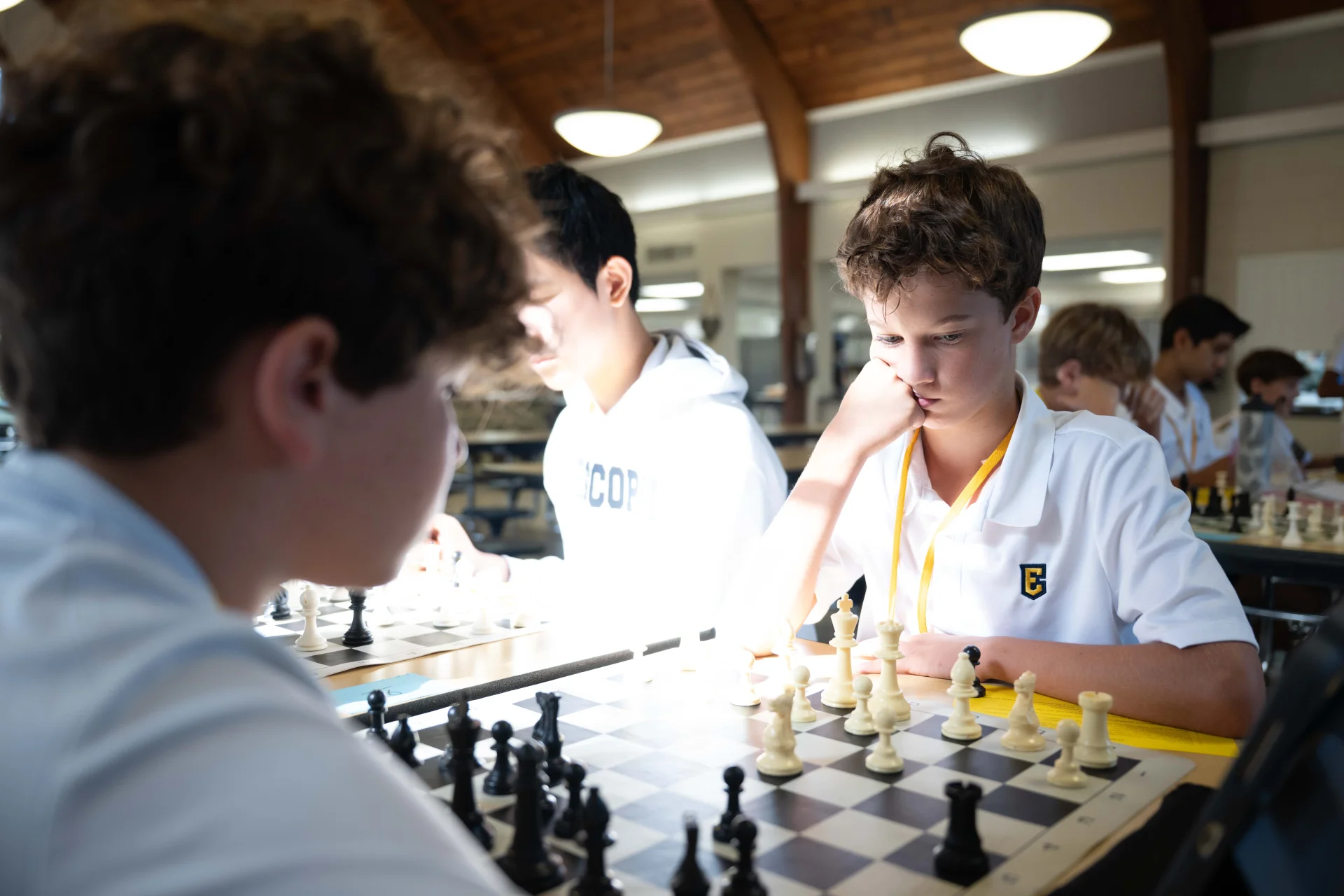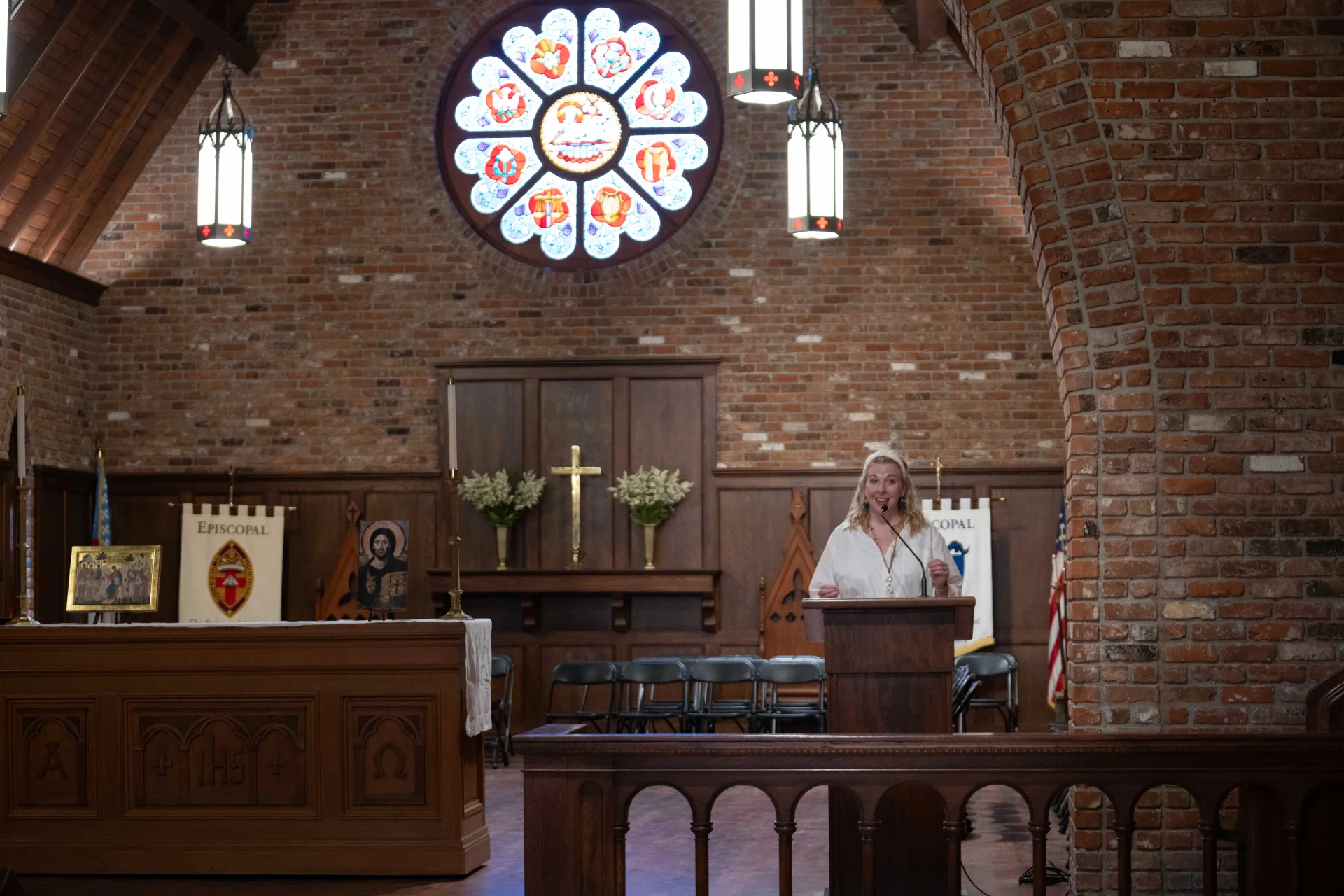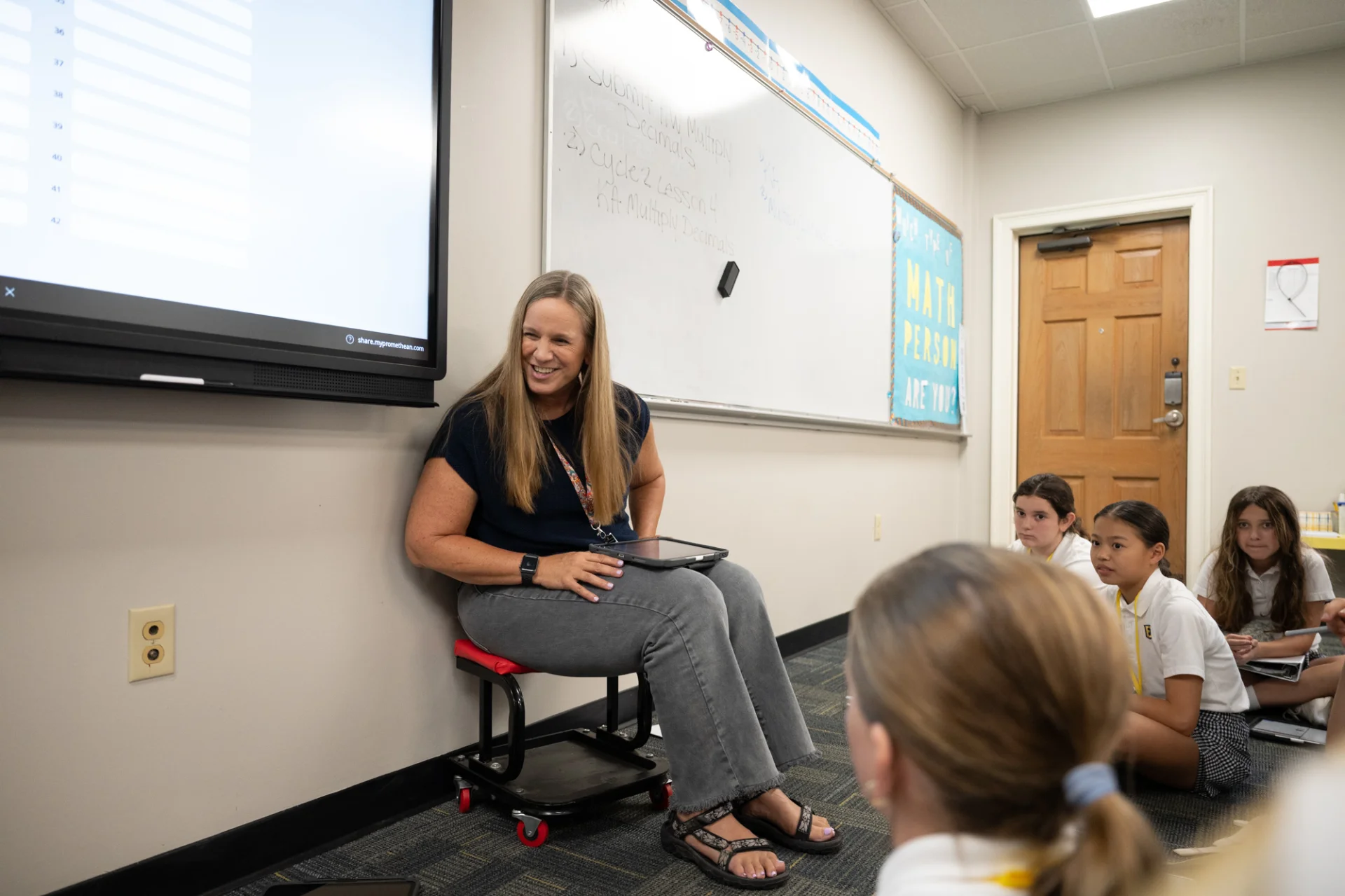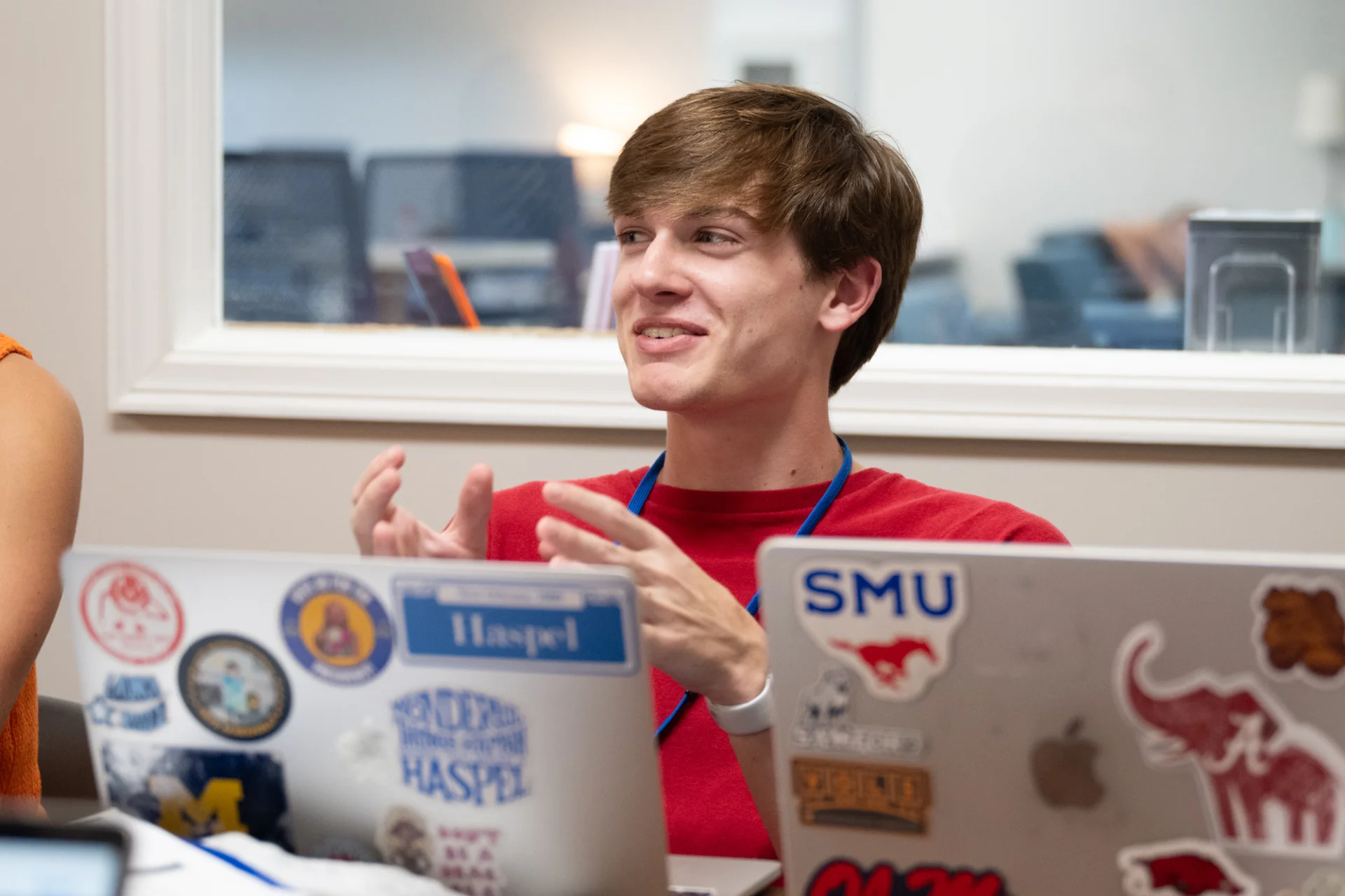- Admission
- Discover Episcopal
- Our Program
- Athletics
- Arts
- Spirituality
- Student Life
- Support Episcopal
- Alumni
- Parent Support
- Knightly News
- Contact Us
- Calendar
- School Store
- Lunch Menu
« Back
ESTAAR: Preparing Tomorrow's Science Leaders
March 21st, 2019

A singer. A cheerleader. A volleyball player. A cross country runner. Episcopal ESTAAR students do so much more than hundreds of hours of science research, presentations and discoveries. These students are juggling the demands of high school with the excitement, rigor and promise of science exploration.
Episcopal Students Take Action in Advanced Research or ESTAAR formally started during the 2012/2013 school year. Dr. Jewel Reuter and Sarah Pulliam worked together to establish the program and the partnerships needed with LSU. Dean of Academics Dr. Sara Fenske says participating Upper School students are partnered with university professors and have the opportunity for real, hands-on lab work. The students lead their own research project where they seek to determine the answer to a scientific question of their choosing. LSU professor Dr. Kevin McPeak, who has worked with ESTAAR students in his lab, says the program is a great opportunity for high school students to gain hands-on experience in science research. "Gaining exposure to nationally competitive science and engineering research programs can be a daunting task for even the most talented high school students,” he says. “ESTAAR provides this opportunity along with a joint LSU-Episcopal support network to ensure the student maximizes their learning experience.”
The opportunity for university lab time as a high school student is extraordinary. Dr. Fenske says to ensure that students are prepared for this caliber of work, they must enroll in a Scientific Research Methodology and Experimentation course in their junior year. The course covers a range of information including basic lab skills, experimental design, communication skills in science, ethics in scientific research, and how to collect and analyze data. After the first semester of the class, students apply to participate in ESTAAR. They are then matched with professors who work in the students’ field of interest.



Three members of the class of 2019 are wrapping up their ESTAAR experience. Clay Burton, Emily Frazer and Abby Johnson all recently presented at the Junior Science and Humanities Symposium at LSU. The experience requires high school students to stand in a room before a panel of judges comprised of professors, researchers and scientific experts and explain their findings. Such an experience requires a deep understanding of the scientific research process and tremendous confidence. In addition to presenting at the symposium, students also presented their research before their classmates at the annual LAUNCH event. The students were poised and spoke with authority.
Confidence is one of the hidden benefits of participating in the ESTAAR program. Dr. Fenske says while the scientific opportunities are exceptional, the life lessons students walk away with should not be underestimated. “I have gained the experience on a college campus all summer while getting to know and interact with professors and graduate school students,” says ESTAAR student Emily Frazer, who presented the Effect of Temperature on Development and Fertility of Nipponaclerda Biwakonesis Scale on Phragmites Cane. “I loved the confidence that I gained from being pushed out of my comfort zone both in science and in speaking.”
Another tremendous benefit from ESTAAR participation is experiencing scientific research first hand. ESTAAR students are designing experiments, conducting the actual research and analyzing the results. Such hands-on learning helps participants further define what their long term career goals should be. “I have learned what it’s like to have a job as a scientist,” says Clay Burton, who presented Using the Urea-Urease Reaction to Control Polymerization. “This has helped guide me in what I want to pursue in college and in my career.” “I initially wanted to participate in ESTAAR to help determine what type of career I wanted to have in the future,” says Abby Johnson, who presented Sonication-Assisted Self-Assembly of Polystyrene Nanosphere Monolayers. “As someone who has always had a wide range of interests from English and foreign language to sciences like chemistry, I wanted to see if ESTAAR could provide me with some clarity in deciding what careers I would enjoy pursuing in the future.”
Based on the experiences of the 2019 participants and the opportunities gained by previous ESTAAR students, the program certainly places these future scientists on a path toward success.

In addition to science, ESTAAR participant Avani Alapati '15 also loves music.

"I'm helping the world."
 Avani Alapati ’15 is currently pursuing a neuroscience major and music minor at Rhodes College in Memphis. While at Episcopal, Avani participated in the ESTAAR program where she studied ways to prevent crop destruction due to a particular worm in Louisiana. The pest causes problems for rice and soy plants, which are key commodities in the region, and Avani spent time in an LSU lab studying affordable ways to eradicate the worm. “It made me love research,” she says. “I felt like I was helping the world, the farmers.”
Avani Alapati ’15 is currently pursuing a neuroscience major and music minor at Rhodes College in Memphis. While at Episcopal, Avani participated in the ESTAAR program where she studied ways to prevent crop destruction due to a particular worm in Louisiana. The pest causes problems for rice and soy plants, which are key commodities in the region, and Avani spent time in an LSU lab studying affordable ways to eradicate the worm. “It made me love research,” she says. “I felt like I was helping the world, the farmers.”
Avani earned second place in the plant sciences division at the district Intel Science and Engineering Fair for her work and later went on to earn honorable mention at the state level Intel competition. In addition, she won the Veterans Award for Science. By her senior year at Episcopal, Avani knew what she wanted to do in college. “I was always into science and math,” she says. “Because of ESTAAR I was able to do both.” That love for science reasoning, combined with her natural creativity made Rhodes College the perfect fit for Avani. While at Rhodes she has continued her scientific pursuits. Early in her school career she worked as an animal behavior observer at the Memphis Zoo. She has also participated in research involving the potential impacts that environmental enrichment, such as yoga and meditation can have on patients with Parkinson’s and Alzheimer’s disease.
Avani is fearless in her pursuit of information and eager to learn more about the topics that interest her. This passion for science and her ESTAAR experience earned Avani the sole neuroscience fellowship offered by the University of Tennessee Medical School for study at Rhodes. Even as she dons her lab coat and focuses on her research, Avani still finds time to sing. She hopes to use her scientific abilities and her creative strengths to continue helping the world.
"I love science."

It’s safe to say that Estelle Crawford ’17 loves science. As a young girl her home was filled with experiments and projects inspired by a 1001 Science Experiments book that her mom, Liz, still has today.
Estelle says initially the ESTAAR science research course was a struggle as she trudged through experiments with no real results. Then it happened. After the trial and error, she got results. “This is science. This is working. This is what is happening,” she remembers saying. Just like lighting a Bunsen burner, Estelle’s former love of science was once again sparked. As an ESTAAR participant, she spent hours in the LSU lab assisting Dr. McPeak and his team on water purification research. Those hours and her passion paid off in a big way. As Estelle interviewed with universities for admissions, they were impressed with her time in the lab. College admissions officers reminded her on numerous occasions to discuss ESTAAR and her lab experience in her interviews with department staff. “I didn’t realize the exposure was a big deal,” says Estelle. “It prepared me for classes. I was ready.” Estelle was ultimately accepted to Birmingham Southern. She earned the Rushton Scholarship, which covered tuition and expenses. “ESTAAR was a huge part of that,” she says.
“I learned so many things about myself,” Estelle says of the ESTAAR experience. She remembers initially being intimidated to walk across a college campus. However, she developed the confidence to take that walk, enter the lab and speak with her professors. Now at Birmingham Southern she is pursuing a major in biology and a minor in psychology with the hopes of earning a PhD.
Estelle says initially the ESTAAR science research course was a struggle as she trudged through experiments with no real results. Then it happened. After the trial and error, she got results. “This is science. This is working. This is what is happening,” she remembers saying. Just like lighting a Bunsen burner, Estelle’s former love of science was once again sparked. As an ESTAAR participant, she spent hours in the LSU lab assisting Dr. McPeak and his team on water purification research. Those hours and her passion paid off in a big way. As Estelle interviewed with universities for admissions, they were impressed with her time in the lab. College admissions officers reminded her on numerous occasions to discuss ESTAAR and her lab experience in her interviews with department staff. “I didn’t realize the exposure was a big deal,” says Estelle. “It prepared me for classes. I was ready.” Estelle was ultimately accepted to Birmingham Southern. She earned the Rushton Scholarship, which covered tuition and expenses. “ESTAAR was a huge part of that,” she says.
“I learned so many things about myself,” Estelle says of the ESTAAR experience. She remembers initially being intimidated to walk across a college campus. However, she developed the confidence to take that walk, enter the lab and speak with her professors. Now at Birmingham Southern she is pursuing a major in biology and a minor in psychology with the hopes of earning a PhD.
Preparing Future Science Stars
As of this May, 22 Episcopal students will have completed the ESTAAR program, including recent graduate Scott Wicker ’18. Wicker presented Non-Traditional Heating Methods for Petrochemical Manufacturing last year at the LSU regional symposium. As a result of his work and his presentation, he qualified to present at the 56th National Junior Science and Humanities Symposium. He was only one of 230 high school students who qualified. In addition, Scott won first place in his category at the Region VII Science Fair and third place at the State Science Fair.
Episcopal Students Take Action in Advanced Research is a tremendous opportunity for students to distinguish themselves in high school, college and beyond. Many of these students are pursuing degrees in science and some have already begun a science-related career. Regardless of their long term goals, all of them have developed the confidence and problem-solving abilities to make a difference in our world.
Read More about ESTAAR
ESTAAR students have been published for their contributions to scientific research. Connor Pellerin ’17 was a part of a paper published by the University of North Carolina Press regarding research on coastal habitats. Click here to see the paper.
The Episcopal School of Baton Rouge 2025-2026 application is now available! For more information on the application process, to schedule a tour, or learn more about the private school, contact us at [email protected] or 225-755-2685.
Posted in the categories All, Upper School.
Other articles to consider
 Sep5Building Community through Chess
Sep5Building Community through ChessMembers of the Middle School Chess Club describe it as a fun opportunity to become a better chess player. Read more about this club that has recently experienced tremendous growth.
See Details Sep4Finding Joy and Community in New Experiences
Sep4Finding Joy and Community in New ExperiencesCarrie Poynot challenges others not to fear failure and to find joy in trying new things. Read her recent Upper School Chapel message.
See Details Aug28Beyond Numbers: Bringing Social/Emotional Learning into Middle School Math
Aug28Beyond Numbers: Bringing Social/Emotional Learning into Middle School MathA recent professional development experience is helping Nancy Callaway weave social/emotional learning into everyday math lessons.
See Details Aug28Pursue Excellence: The Center for Excellence in Teaching & Learning
Aug28Pursue Excellence: The Center for Excellence in Teaching & LearningEpiscopal’s Center for Excellence in Teaching & Learning strengthens the school’s 60+ year tradition of academic rigor and support by combining resources, peer mentoring and innovative teaching in one collaborative space.
See Details
Categories
- All
- Admission
- Athletics
- College Bound 2019
- College Bound 2020
- College Bound 2021
- College Bound 2022
- College Bound 2023
- College Bound 2024
- College Bound 2025
- Counselors Corner
- Episcopal Alumni
- Giving
- Head Of School
- Lower School
- Middle School
- Spirituality And Service
- Student Work
- The Teachers' Lounge
- Upper School
- Visual And Performing Arts
Recent Articles
- 09/5/25Building Community through Chess
- 09/4/25Finding Joy and Community in New Experiences
- 08/28/25Beyond Numbers: Bringing Social/Emotional Learning into Middle School Math
- 08/28/25Pursue Excellence: The Center for Excellence in Teaching & Learning
- 08/21/25Social Studies Teacher Julie Weaver Selected for Holocaust Memorial Museum Fellowship











